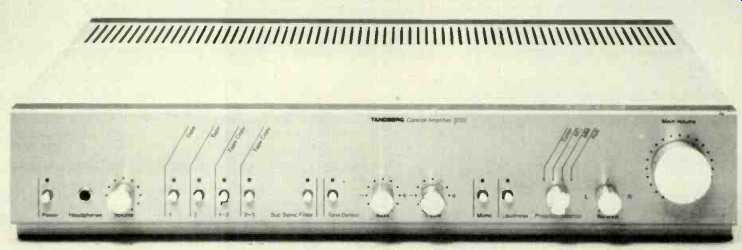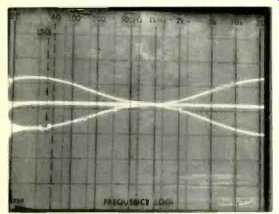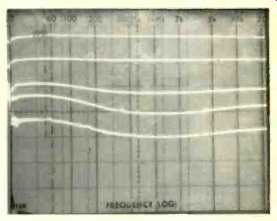
Manufacturer's Specifications:
Frequency Response: MM and MC phono, 20 Hz to 20 kHz, ±0.2 dB; high level, 20 Hz to 20 kHz, +0,-0.1 dB.
Maximum Output Voltage, Preamp Out: 10 V at clipping level.
THD: Less than 0.004% with all program source inputs.
Input Sensitivity: MM phono, 1 mV; MC phono, 80 µV; high level, 70 mV, all referenced to 0.5-V out.
S/N Ratio: MM phono, 5 mV in, 80 dB; MC phono, 0.5 mV in, 74 dB; high level, 0.5 V in, 97 dB, all A weighted for 0.5-V out.
Maximum Input Voltage at 1 kHz: MM phono, 290 mV; MC phono, 22 mV; high level, 11 V.
Input Impedance: MM phono, selectable, 33/47/100 kilohms; MC phono, kilohm; high level, 47 kilohms.
Output Impedance: Preamp, 560 ohms; headphones, 470 ohms, 4 ohm minimum loads.
Bass and Treble Control Range: ± 10 dB at 50 Hz and 10 kHz.
Subsonic Filter: -3 dB at 15 Hz, 12 dB/octave slope.
Crosstalk: Better than 70 dB, any source to any other source.
Stereo Separation: Phono, better than 53 dB; high level, better than 58 dB.
TIM: Unmeasurable.
Power Requirements: 120 V, 60 Hz, 30 watts.
Dimensions: 17 1/8 in. (43.49 cm) W x 31/4 in. (8.25 cm) H x 13 3/4 in. (34.92 cm) D.
Weight: 12 1/2 lbs. (5.62 kg).
Price: $795.00.
I had the good fortune to visit the Tandberg plant in Oslo, Norway nearly three years ago, when their new 3000 series components (including the TCA 3000 preamplifier) were in their first prototype stages. I was extremely impressed with the tentative design of the preamp; I am even more impressed with the finished product as it finally evolved. There may be those who will argue that Tandberg has not followed the "straight wire with gain" approach espoused by many purists, while others will maintain that they would have preferred more control features and facilities. Be that as it may, I can tell you that after living with the Tandberg TCA 3002 for several months, I believe it is one of the best designed and most intelligently constructed preamp/control chassis I have ever had in my laboratory or listening room.
A quick look at the control layout first reveals the high level of human engineering employed in this design. At the extreme left we find a pushbutton power switch with an indicator light above it. A headphone jack with its independent output level control comes next, followed by a pair of tape monitor switches and a pair of tape copy (dubbing) switches, all with tiny indicator lights above them. A subsonic filter switch is followed by a tone defeat switch, rotary bass and treble control knobs, mono/stereo and loudness switches, a rotary program selector switch (with settings for tuner, MC and MM phono, and AUX), a rotary balance control, and a large rotary main volume control.
The rear panel of the TCA 3002 has three switched and one unswitched convenience a.c. receptacles, a fuse-holder, a recessed switch by means of which the unit's operating voltage can be changed from 115 to 230 volts or vice versa, the requisite number of input and output jacks, and a chassis ground terminal. Near the MM and MC phono input jacks are a pair of three-position toggle switches. The first of these selects resistance loading of moving-magnet cartridges of 33, 47, or 100 kilohms, while the second switch adds 20, 120, or 350 pF to the capacitance already offered by the audio connecting cables from the turntable system.
Circuit Description
The TCA 3002 has 16 push-pull stages with 14 constant current sources. Phono preamps for moving-magnet and moving-coil cartridges are completely independent of each other. Each phono preamp has 11 transistors and a linear buffer stage before RIAA equalization in a full, discrete, symmetrical design. The linear buffer stages, according to Tandberg, have a slew rate of more than 300 V/µS so that transients are not altered at the phono input section. Instead of incorporating the entire RIAA equalization characteristic in a negative feedback loop (as is done with many phono preamplifier circuits), Tandberg used a passive 75-µS treble cut for the high-end portion of the RIAA curve and an active bass-boost circuit for the low end. Components of 1% tolerance are used to achieve a high level of RIAA accuracy over the entire audio range.
High-level signals (tape, tuner, AUX) are each fed into their own input amplifiers. The amps used are two-stage, constant-current types with excellent linearity and low distortion. The subsonic filter circuit is an active two-pole highpass filter designed as a push-pull stage with symmetrical input. In its high-level amplification circuits, the TCA 3002 uses specially designed 9-dB-per-octave compensation circuits which extend open-loop frequency response for increased stability and high-speed waveform response.
Tone controls are of the low-impedance type and are fed from a constant-current source. A five-transistor amplifier stage with push-pull output and constant current is used to drive the feedback circuit in the tone controls.
Aside from the elegance of the circuitry itself (no ICs are used and there are a total of 24 amplifier stages with no fewer than 116 transistors), I have always admired Tandberg's chassis layouts. With its clean layout and minimal wiring, the inside of the TCA 3002 is no exception. For example, all input jacks are wired directly to the main p.c. board, and the MC amplifier circuitry is as far away from the main power transformer as it could physically be in a chassis of these dimensions.
Measurements
Tandberg is one of the few companies that has completely converted its published specifications to fully conform to the latest IHF (now an EIA subdivision) standards for amplifier and preamplifier measurements. Since I have been measuring equipment in accordance with those standards for a couple of years now, it was nice to test a unit and get direct correlation between what I measure and what the manufacturer claims. For example, input sensitivity (which, in the new standard, is referred to a 0.5-volt output) for MM phono was almost precisely 1.0 mV as claimed; using the MC input, a signal of 75 µV (at 1 kHz) was required to produce reference output as against Tandberg's published value of 80 V. High-level inputs needed 72 mV to produce the reference 0.5-volt output level as against 70 mV claimed. These differences are, of course, negligible.
I was fully prepared to find a poorer S/N figure in phono than the 80 dB claimed by Tandberg (for the MM phono input), keeping in mind that this measurement is once again referred to an output voltage of 0.5 volt and that the reference input is 5 mV (not the 10 mV so many manufacturers continue to use in order to make their S/N numbers look better). Imagine my surprise, therefore, when I obtained an A-weighted measurement of 88 dB for the moving-magnet input and 81 dB for the moving-coil input (as against Tandberg's claimed 74 dB for the MC phono input). As for the high-level inputs, my S/N readings (again, referred to 0.5 volt output with a referenced input of 0.5 volt) was more like 100 dB rather than the 97 dB claimed by Tandberg. Phono overload measured 300 mV for MM and 24 mV for MC. The moving-coil inputs, incidentally, provided an additional gain (compared with the MM inputs) of approximately 21.5 dB. Figure 1 is a plot of the frequency response of the phono equalizer/preamp section of this unit. An inverse RIAA input signal was fed to the MM phono inputs, and, using a Sound Technology 1500A tester, a video printout was produced.

Fig. 1--Using the inverse of an RIAA playback curve, maximum deviation from
perfect RIAA equalization with the Tandberg TCA 3002 was +0.3 dB at 40 Hz.
Fig. 2--RIAA playback curve shown with and without subsonic filter activated. Bass boost at 21 Hz was +19.2 dB without filter and +17.6 dB with filter.

Fig. 3--Tone control range.

Fig. 4--Loudness control action at various volume settings.
Deviations from flat response are seen at the extreme bass end (the plot is logarithmic, from 20 Hz to 20 kHz, and vertical amplitude is 2 dB per division). The dotted line cursor has been set to read the greatest deviation from perfect RIAA response, which measured +0.3 dB at 40 Hz. Note that since there are virtually no negative (-) deviations, the Tandberg claim of "±0.2 dB" is easily met.
Even that minute deviation from perfect RIAA response is offset if you activate the subsonic filter. Under these circumstances, there is enough in-band attenuation at the bass end to pull the bass boost at 21 Hz down from + 19.2 to + 17.6 dB, as shown in the two RIAA curves reproduced in Fig. 2 (this time using a constant input signal instead of an inverse RIAA signal). In Fig. 2, vertical sensitivity was 10 dB per division so that the entire playback equalization curve could be displayed in the graph.
The range of bass and treble controls of the Tandberg TCA 3002 is shown in the multiple spectrum analyzer plots of Fig. 3. Here, too, the plot is logarithmic from 20 Hz to 20 kHz, and vertical sensitivity of the display is 10 dB per division. The moderate action of the loudness control circuit is shown in the multiple curves of Fig. 4. Notice that even when the main volume control is rotated for a full 40 dB of attenuation relative to maximum volume, bass boost is limited to around +7 dB while treble emphasis is no more than +3 dB. If one can't have a truly continuous variable loudness control (as is found in some Yamaha amps and receivers), I suppose this is the next best thing.
Frequency response for the high-level inputs of this control unit extended from around 3.5 Hz to 85 kHz for a-1.0 dB roll-off and out to 155 kHz for the -3 dB point. The main volume control, incidentally, tracked remarkably well-so well in fact that at the -80 dB level (referenced to maximum volume control setting) there was less than a 0.5 dB discrepancy in gain between channels! That's what I call accurate dual control tracking.
Use and Listening Tests
The Tandberg TCA 3002 proved to be an incredibly quiet and distortion-free preamp control unit. I conducted listening tests with both moving-coil and moving-magnet cartridges. With a moving-coil cartridge, I was particularly impressed by the total absence of background hiss and hum which so often has accompanied other preamplifier circuits I have auditioned. If you favor a moving-coil cartridge, you won't need to accept any signal-to-noise compromises when it's hooked up to the TCA 3002.
Regardless of which type of cartridge I used, the preamp itself had plenty of dynamic range and delivered an open and clean output signal to the reference power amplifier and speakers. With the tone controls set to their flat positions, I could detect no change in gain or coloration when the tone defeat switch was pushed in or out. The small built-in headphone amplifier was able to deliver plenty of drive voltage to low-impedance phones (it produces 0.465 V into 8 ohms when the main output jacks are set to reference voltage of 0.5 V and its own level control is at maximum). While Tandberg's TCA 3002 is not the least expensive preamplifier/control amplifier available, it should be noted that designing and producing a unit with the level of sophistication embodied here cannot be done cheaply. In any case, the price is at a level where most knowledgeable audio enthusiasts can enjoy its sonic and engineering excellence.
---Leonard Feldman
(Source: Audio magazine, Apr. 1982)
Also see:
Tandberg TCA 3018A Preamp and TPA 3026A Amp (Apr. 1987)
Tandberg TPT 3001A Tuner and TIA 3012 Amp (Nov. 1983)
Tandberg 3080A FM Receiver (July 1989)
Tandberg 3008A Preamp and 3009A Amp (Jan. 1986)
Vendetta Research SCP-2B Pre-Preamp (Dec. 1990)
= = = =